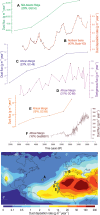Strong links between Saharan dust fluxes, monsoon strength, and North Atlantic climate during the last 5000 years
- PMID: 34172437
- PMCID: PMC11559594
- DOI: 10.1126/sciadv.abe6102
Strong links between Saharan dust fluxes, monsoon strength, and North Atlantic climate during the last 5000 years
Abstract
Despite the multiple impacts of mineral aerosols on global and regional climate and the primary climatic control on atmospheric dust fluxes, dust-climate feedbacks remain poorly constrained, particularly at submillennial time scales, hampering regional and global climate models. We reconstruct Saharan dust fluxes over Western Europe for the last 5000 years, by means of speleothem strontium isotope ratios (87Sr/86Sr) and karst modeling. The record reveals a long-term increase in Saharan dust flux, consistent with progressive North Africa aridification and strengthening of Northern Hemisphere latitudinal climatic gradients. On shorter, centennial to millennial scales, it shows broad variations in dust fluxes, in tune with North Atlantic ocean-atmosphere patterns and with monsoonal variability. Dust fluxes rapidly increase before (and peaks at) Late Holocene multidecadal- to century-scale cold climate events, including those around 4200, 2800, and 1500 years before present, suggesting the operation of previously unknown strong dust-climate negative feedbacks preceding these episodes.
Copyright © 2021 The Authors, some rights reserved; exclusive licensee American Association for the Advancement of Science. No claim to original U.S. Government Works. Distributed under a Creative Commons Attribution NonCommercial License 4.0 (CC BY-NC).
Figures




Similar articles
-
Glacial to Holocene changes in trans-Atlantic Saharan dust transport and dust-climate feedbacks.Sci Adv. 2016 Nov 23;2(11):e1600445. doi: 10.1126/sciadv.1600445. eCollection 2016 Nov. Sci Adv. 2016. PMID: 28138515 Free PMC article.
-
Abrupt changes in the Asian southwest monsoon during the Holocene and their links to the North Atlantic Ocean.Nature. 2003 Jan 23;421(6921):354-7. doi: 10.1038/nature01340. Nature. 2003. PMID: 12540924
-
Holocene centennial to millennial shifts in North-Atlantic storminess and ocean dynamics.Sci Rep. 2018 Aug 24;8(1):12778. doi: 10.1038/s41598-018-29949-8. Sci Rep. 2018. PMID: 30143649 Free PMC article.
-
A review of global environmental mercury processes in response to human and natural perturbations: Changes of emissions, climate, and land use.Ambio. 2018 Mar;47(2):116-140. doi: 10.1007/s13280-017-1004-9. Ambio. 2018. PMID: 29388126 Free PMC article. Review.
-
Variability, interaction and change in the atmosphere-ocean-ecology system of the Western Indian Ocean.Philos Trans A Math Phys Eng Sci. 2005 Jan 15;363(1826):3-13. doi: 10.1098/rsta.2004.1495. Philos Trans A Math Phys Eng Sci. 2005. PMID: 15598616 Review.
Cited by
-
Climate, biogeography, and human resilience in the demographic history of the Canary Islands during the Amazigh period.Sci Rep. 2025 Jun 3;15(1):19485. doi: 10.1038/s41598-025-04302-y. Sci Rep. 2025. PMID: 40461538 Free PMC article.
-
Arctic amplification-induced decline in West and South Asia dust warrants stronger antidesertification toward carbon neutrality.Proc Natl Acad Sci U S A. 2024 Apr 2;121(14):e2317444121. doi: 10.1073/pnas.2317444121. Epub 2024 Mar 25. Proc Natl Acad Sci U S A. 2024. PMID: 38527208 Free PMC article.
References
-
- Carslaw K. S., Boucher O., Spracklen D. V., Mann G. W., Rae J. G. L., Woodward S., Kulmala M., A review of natural aerosol interactions and feedbacks within the Earth system. Atmos. Chem. Phys. 10, 1701–1737 (2010).
-
- Solmon F., Mallet M., Elguindi N., Giorgi F., Zakey A., Konaré A., Dust aerosol impact on regional precipitation over western Africa, mechanisms and sensitivity to absorption properties. Geophys. Res. Lett. 35, 1–6 (2008).
-
- Kotsyfakis M., Zarogiannis S. G., Patelarou E., The health impact of Saharan dust exposure. Int. J. Occup. Med. Environ. Health 32, 749–760 (2019). - PubMed
-
- Ginoux P., Prospero J. M., Gill T. E., Hsu N. C., Zhao M., Global-scale attribution of anthropogenic and natural dust sources and their emission rates based on MODIS Deep Blue aerosol products. Rev. Geophys. 50, 1–36 (2012).
-
- O. Boucher, D. Randall, P. Artaxo, C. Bretherton, G. Feingold, P. Forster, V.-M. Kerminen, Y. Kondo, H. Liao, U. Lohmann, P. Rasch, S. K. Satheesh, S. Sherwood, B. Stevens, X. Y. Zhang, in Climate Change 2013 the Physical Science Basis: Working Group I Contribution to the Fifth Assessment Report of the Intergovernmental Panel on Climate Change, T. F. Stocker, D. Qin, G.-K. Plattner, M. Tignor, S. K. Allen, J. Boschung, A. Nauels, Y. Xia, Eds. (Cambridge University Press, New York, 2013), pp. 571–658.
LinkOut - more resources
Full Text Sources
Research Materials

